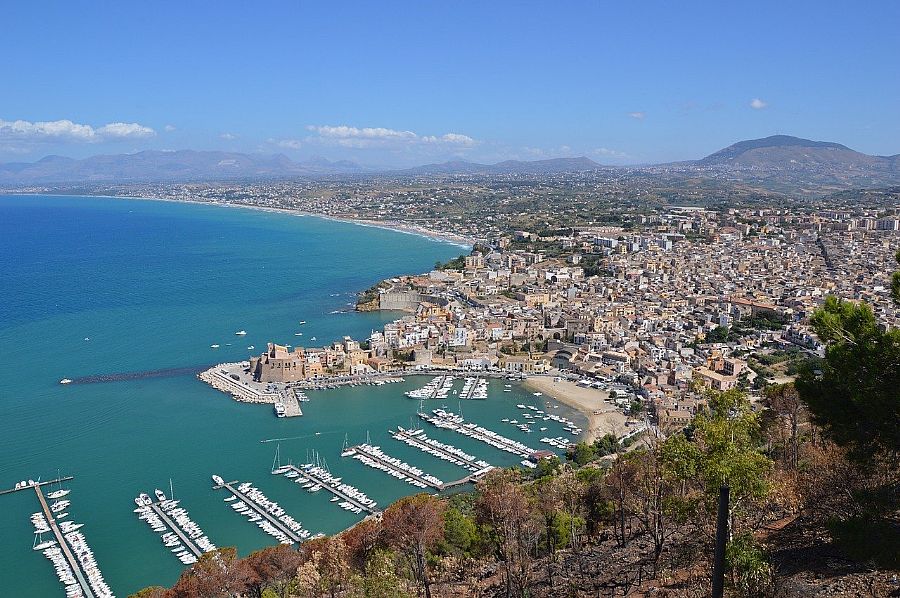Mazara del Vallo

An intriguing and exotic city of 51,300 people, Mazara del Vallo has a melding of cultures and a mix of interesting sights, along with choice beaches. Set on the sea with a river-port and fishing harbor, it is closer to Tunisia than to Messina. Its contact with Northern Africa marked the towns fabric, along with the many others who came through. It was a crossroads that saw many groups: Phoenicians, Greeks, Carthaginians, Romans, Byzantines, Arabs, Normans, along with Spanish and French rulers.
A BIT OF HISTORY. It was a Phoenician settlement called Mazar, meaning fortress, then in 406 BC passed under the domain of Segesta and the Greek Selinunte. In 392 it fell under Siracusa. The Arabs arrived and developed the town center, building a mosque and making Mazara a center of Islamic studies in literature and poetry. They also brought a new crop, citrus, with lemons and oranges growing well here. The commercial port flourished with trade to northern Africa and Spain. The Normans arrived and under Ruggero I saw a lightening transformation, with the mosque being replaced by the Basilica Cathedral, and the territory being turned into the latifondi system -basically feudal territory. Following the Normans were a series of rulers, like all of Sicily and much of southern Italy.
AROUND MAZARA DEL VALLO. This town has fascinating things to see. First, the kasbah, the old web of streets that made up the Arab town, still intact. The Museo del Satiro Danzante holds an extraordinary piece, the namesake "dancing satyr" ancient bronze sculpture, found by chance by fishermen and recovered. It incredibly has the marble eyes intact, a rarity among ancient bronzes. It is a must see, and the museum holds some amphorae and other archeological relics. In Piazza Mokarta, you'll want to see the Norman arch and the remains of the ancient castle. Piazza della Repubblica is the main square in town, where you'll find the splendid cathedral and facing it, the Palazzo Vescovile, or bishop's palace, from the 16th century. Also the Palazzo del Seminario from 1710.
- The Teatro Garibaldi theater is unique, built in 1848 built by mariners from recycled boat wood. (It was originally called Teatro del Popolo but renamed after the unification to honor General Garibaldi.)
- The remains of an aqueduct from the 16th century in Contrada Fiumara, at the upper edge of the city
- Diocesan Museum with sacred art and items, and historical carriages
- Mirabilia Urbis at the church of San Bartolomeo shows artifacts from archeological digs, including the "tomb of the shaman" and everyday items from ancient cultures.
- The ruins of the church of Sant'Ignazio -magical!
- Church of San Francesco, an over-the-top baroque church that is so adorned you won't believe it
- Walk along the river-docks where the fishing boats line up, and warehouses are still kept. Mazara is still an important fishing town. You can cross the river by way of a shuttle boat as you make your way up.
Of course, the beaches beckon, and you'll find both sandy beaches and rocky patches, depending on your taste.
Around town, there are loads of restaurants, cafes and wine bars, along with shops and boutiques, so you won't go hungry or thirsty, and you'll enjoy all those Sicilian specialties.
<span style="color: rgb(66, 66, 66); font-family: -apple-system, BlinkMacSystemFont, " segoe="" ui",="" roboto,="" oxygen,="" ubuntu,="" cantarell,="" "fira="" sans",="" "droid="" "helvetica="" neue",="" sans-serif;="" font-size:="" 16px;"="">
Enjoy the comfort of a home rental in Mazara del Vallo.

 Amalfi Coast
Amalfi Coast Sorrento Coast
Sorrento Coast Tuscany
Tuscany Cilento National Park
Cilento National Park Lake Como
Lake Como Rome and Latium
Rome and Latium Umbria
Umbria Capri and Ischia
Capri and Ischia Venice
Venice Puglia (Apulia)
Puglia (Apulia) Liguria
Liguria Sicily
Sicily Lake Maggiore
Lake Maggiore Lombardy
Lombardy Sardinia
Sardinia Lake Garda
Lake Garda Abruzzo and Marche
Abruzzo and Marche Calabria
Calabria

